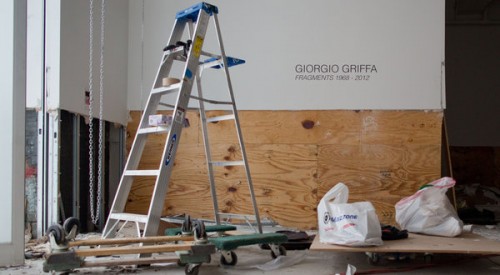It’s now been just over a month since I watched on the news as houses and lives were swept away, feeling guilty and isolated as I sat on my couch in Park Slope, Brooklyn, where the lights were still on. For awhile, art was the farthest thing from my mind as I worried about friends living throughout the boroughs, and my family in Connecticut. Then, a colleague sent me Linda Yablonsky’s article about the gallerists and artists who pooled efforts to wade through their flooded spaces, salvaging and throwing away art, to say nothing of the damage done to the spaces themselves. I began to encounter stories of the cost and the hours of labor lost when art works were destroyed, and to see galleries with “Closed until Further Notice” signs because they cannot afford to reopen.
In many of these stories, there was a recurring disparity between what gallerists and artists expected the storm to deliver, and what they ended up dealing with. David Zwirner told the New York Times that they had gotten four feet of water in the gallery where they only expected a foot. Some galleries didn’t have enough water pumps on hand, or did not elevate their artworks to adequate heights. (Days before the storm hit, I ran into a friend who works with a gallery in Chelsea and, naively, we agreed to meet for lunch on the day after the hurricane hit.) Jim Kempner, of Jim Kempner Fine Arts, made light of his own miscalculation in a parodic video about under-estimating the hurricane that he dedicated to the “enduring spirit of the Chelsea art world.” The footage of the flooded gallery is jaw-dropping, even amidst the video’s humor.
[vimeo:https://vimeo.com/53457321]
I think there are a number of ways to assess the lingering effects of this communal tragedy. Reporters and advisors have made speculations based on the major art auctions taking place this past month. I think we can also take measure in the outcome of this week’s art fairs in Miami, where a number of galleries that have not yet been able to reopen their spaces in New York can use their booths as satellite galleries to help keep their programs running.
Over the next two weeks, which will coincide with some of the major recovery efforts that are just beginning, or already underway, I want to address the valiant efforts that are being made by the members of our art communities. I also want to respond to the public criticism that Yablonsky’s article and similar reports received for likening this devastation to other tragedies–criticisms that have often been punctuated with a hasty and dismissive “It’s just art! Who cares!” While it’s necessary to maintain a grounded perspective in situations of loss, it is also important to remember that Sandy has irrevocably impacted the livelihoods and businesses of million of other people around the world. I hope that the stories I collect will help to show the range of experiences and attitudes that people have taken in times of crisis, and their continuing efforts to regain some sense of normalcy. Of course, this two-week project is limited to telling the stories of those I personally encounter, though I hope that this may also serve as a forum for connecting with others and finding support.
